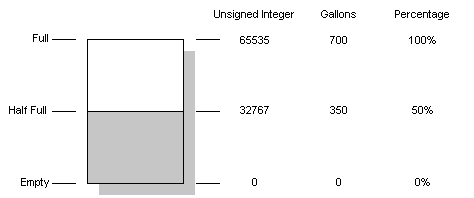Very often raw values from your process hardware are not meaningful to operators. This is particularly true when the hardware reports values in a numeric format, such as an unsigned integer, to indicate how full a tank is. In this situation, what is needed is a way to map the range of values you receive into a different range of values. Many I/O drivers provide this ability by applying signal conditioning.
Signal conditioning converts the data received from the process hardware into a format that is easily recognizable by operators. You can apply signal conditioning by selecting the type you want to use from a block's Signal Conditioning field.
Example: Understanding Signal Conditioning
Suppose you have a 700-gallon water tank and you want to display how much water is in the tank. You can display the tank's water level as:
- Unscaled integer received from your process hardware
- Gallons
- Percent filled
For this example, assume the I/O driver sends an unsigned integer to the process database (that is, 0 to 65535). The following table lists sample high and low EGU limits you could assign to the input block. These settings scale the incoming values to display the tank's water level in percent filled and in gallons.
|
Operator Display: |
Limit Settings: |
|
Unsigned Integer |
0 to 65535 |
|
Percent |
0 to 100 |
|
Gallons |
0 to 700 |
The following figure shows the values that are displayed when the tank is full, half full, and empty.
Scaling Values
See Also
Important Notice
You do not have the latest version of iFIX! You are missing out on the newest capabilities and enhanced security.
For information on all the latest features, see the iFIX product page.
For more information on upgrades, contact your GE Digital sales agent or e-mail GEDClientServices@gevernova.com.
For the most up-to-date documentation, go here.

